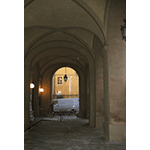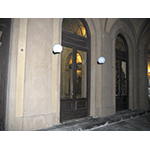Teatro Verdi [Verdi Theatre]
The Teatro Verdi, the former "Regio Teatro Nuovo" [Royal New Theatre], dates from the second half of the 19th century. Built to the project of the Venetian architect Andrea Scala, at the time of its inauguration (1867) it had an ovoidal ground plan with five orders of boxes and a stage with inclined plane of imposing proportions. According to the documents of the time, conserved in the theatre's historic archives, 3621 pinewood poles were used to support the foundations alone.
Decorated by the famous artist Annibale Gatti, who painted the curtain and the ceiling of the present-day concert hall (once a dance hall), the theatre underwent various transformations over the course of the 20th century, designed to increase its capacity and to modernise the stage sets. In 1907 the original gas light system was replaced by an electric lighting system, with a delay of a little over twenty years in respect to La Scala in Milan, the first in Italy (1883) to adopt this innovative, revolutionary lighting system. In the following years substantial modifications were made, instead, in the main hall, such as the shortening of the stage, which still remained one of the largest in Italy.
One of Tuscany's most important theatres, the Verdi in Pisa presents each year a rich program of theatre and music. In addition, it has a small exhibition section containing costumes and theatrical objects that belonged to the famous baritone Titta Ruffo, as well as interesting documentation on both paper and recordings coming from the Giuntini collection, consisting of books, musical scores, vinyl records and historic photographs pertinent to Italian and European theatres.
****************************
Texts by Elena Fani
English translation by Catherine Frost
Last update 05/feb/2008





